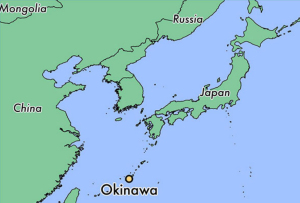Birthplace of Karate
The tiny island of Okinawa is known as the birthplace of both karate and its lesser known cousin, kobudō. From Okinawa, karate spread to Japan through the efforts of karate master and educator, Gichin Funakoshi. Karate spread to the rest of the world after the end of World War II, carried back home by servicemen who had been stationed in Okinawa. It can be said that Okinawa’s most famous export was and continues to be karate, itself.
About Okinawa
Okinawa is the largest island in a group of islands that make up the Okinawa Prefecture of Japan. A prefecture is a political entity much like a state in the U.S. The island of Okinawa is 70 miles long and 7 miles wide. By comparison, the state of Hawaii is 23 times as large as Okinawa Prefecture.
The island of Okinawa is subtropical, growing sugar cane, pineapples and cut flowers, most notably orchids. It is subject to numerous typhoons during the typhoon season, which peaks in August and September. Since a typhoon loses power as it travels northward, typhoons that reach land in Okinawa are typically more powerful than typhoons that hit the more-northern main islands of Japan.
Where in the World Is Okinawa?
The islands of the Okinawa Prefecture are part of the Ryūkyū Islands, a group of islands in the East China Sea that stretch from Kyūshū, the southern-most of the four main islands of Japan, southwest to Taiwan. The Ryūkyū Islands are coral in origin. The soil is poor and metals are scarce.

Midway Between Taiwan and Kyūshū
Ancient History
For its small size, Okinawa has enjoyed a colorful history. Like Hawaii, Okinawa was once an independent country. That country was called the Ryūkyū Kingdom. Since 1372, as a tributary state of the Ming Dynasty, the Ryūkyū Kingdom was dominated culturally and economically by China. In 1609, the Ryūkyū Kingdom was conquered by Japan, a fact which was kept secret from China for the next two hundred years or so. In 1872, the Ryūkyū Kingdom was abolished by Japan. In 1879, Okinawa was made a prefecture (a political entity similar to a state) of Japan.
The Birthplace of Karate and Kobudo
The island of Okinawa is the birthplace of both karate and its lesser known cousin, kobudō. The history of karate and kobudō is inseparable from the history of the tiny island kingdom of Ryūkyū.
The exact origin of the peoples who first settled the Ryūkyū Islands is clouded by time and legend, as is the shadowy origin of an indigenous form of hand-to-hand combat featuring striking, kicking and grappling – a fighting art reported as early as the sixth century. Indeed, karate-like movements can still be seen in traditional Okinawan dances passed down from times before recorded history. The indigenous fighting art of Okinawa was known as te (ti in Okinawan hogan), meaning hand.
Te was honed by exposure to many cultural and historical influences as the Ryūkyū fisherman plied their trade throughout Southeast Asia, China and north to Korea and Japan. Variations of te developed: Shuri-te in the capital city of the Ryūkyū Kingdom and Tomari-te and Naha-te in port areas. Because of the strong influence of Chinese chuan’fa, these forerunners of modern karate became known as Tōde, meaning China hand. Only in the early 1900s did Tōde become known as karate.
Historically, banned by the conquering Japanese, karate and kobudō were practiced in secret. Passed from father to eldest son, karate and kobudō were little known, even on the island of Okinawa. Once the Ryūkyū Kingdom was abolished and Okinawa was made a prefecture of Japan, karate and kobudō could come out of the shadows.
Karate gained in popularity after the end of World War II, spreading throughout the world. Indeed, karate might be considered Okinawa’s greatest export. Kobudō, the study of the humble weapons of ancient Okinawa, has never achieved the popularity of karate. For better or worse, kobudō has gained steadily in popularity in recent years.
The Chinese Influence
If you click “View larger map” and zoom out you will see the coastline of China. The city of Fuzhou in the Fujian Province of China is almost due west of Naha, Okinawa. It is the closest point of mainland China to Okinawa. Taiwan was also a sea-trading partner of Okinawa during the days of the Ryūkyū Kingdom.
A Brief History of Okinawa
It is useful to understand why Okinawa, even though a prefecture of Japan since 1879, remained almost like a foreign country to Japan. The long association of Okinawa with China, often an adversary of Japan, and the prohibition against learning the Japanese language or adopting Japanese culture, because of its long association with China.
- 1372 The Ming Dynasty of China sends envoys to the three warring kingdoms on the tiny island of Okinawa. Tribute missions to China began.
- 1429 The three kingdoms are united and become the Ryūkyū Kingdom. Tribute missions continue. The missions were occasions of great pomp and cultural exchanges, including the martial arts. Okinawa te became strongly influenced by Chinese chuan’fa.
- 1477 The “Golden Age of Ryūkyū.” begins.
- 1609 The Satsuma clan of Japan, covetous of the Ryūkyū Kingdom’s lucrative trade relationship with the Ming Dynasty, conquered the Ryūkyū Kingdom with the goal to siphon off profits from the Ryūkyū Kingdom’s trade. In order to cement their rule, the Satsuma banned the martial arts of Okinawa, driving the practice of the martial arts underground. The Okinawan people were prohibited from learning the Japanese language or adopting Japanese culture in order to keep Japanese control over the Ryūkyū Kingdom secret. The Ryūkyū Kingdom found themselves paying monetary tribute to both China and Japan at a time when the profits were already diminishing. The Golden Age came to an end.
- 1877 The Ryūkyū Kingdom is abolished by Japan and the tributary relationship with China is ended.
- 1879 The Okinawa Prefecture (somewhat like an American state) is established.
